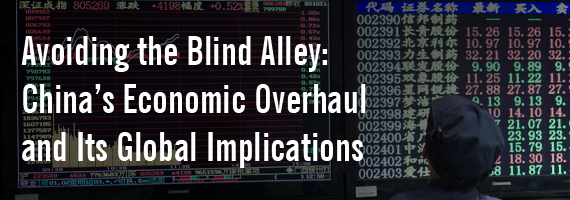In part one of the executive summary, Daniel H. Rosen explains the context and analytical approach for “Avoiding the Blind Alley,” an Asia Society Policy Institute report produced in collaboration with Rhodium Group.
President Xi Jinping announced a sweeping overhaul for China’s economy in November 2013, with pledges to make market forces decisive, treat homegrown and foreign investors with the same laws and regulations, and change the mission statement of the government. The reform program, known as the Decisions plan and presented at the Communist Party leadership’s Third Plenum meeting, is comprehensive and marks a turning point in China’s modern history. The degree of boldness also indicates that after 35 years of world-beating economic performance, China’s development model is obsolete and in need of urgent, not gradual, replacement. To justify the risks, President Xi quoted an impassioned plea for policy modernization by his predecessor Deng Xiaoping: the only way to avoid a dead end — a blind alley — is to deepen reform and opening both at home and with the world.
Despite this clarion call, observers in China and abroad have found several reasons to wonder what shape the reforms will take and whether they can be put into full effect. First, the announced program is idiosyncratic and difficult to benchmark against advanced-economy models. Second, as with earlier waves of Chinese reform, the 2013 program leaves room for experimentation, and the final design of regulations is not specified. Third, some of the same commitments have been promised before and not delivered, leaving analysts cynical. Fourth, and importantly, full implementation of the principles set out — such as a decisive role for market forces in allocating resources — portends a greater transfer of Party control over the economy than is thought to be palatable to China’s leaders. Therefore, rather than bringing about a sea change in business and policy expectations about China’s course, this new agenda has amplified debate.
To resolve uncertainties, this study assesses the content of China’s economic reform program and indications of its progress during its first year. We find that the program’s redefined mission statement for government and nine major clusters of regulatory overhaul are convergent with advanced-economy notions of economic governance. Moreover, we conclude that — on balance — China’s leadership is moving ahead across all economic dimensions with purpose and urgency, though at varying speeds, and is simultaneously addressing the obstacles that have hampered systemic reform in the past and continue to complicate implementation today. That said, the consolidation of power, key to overcoming those impediments to reform today, creates its own problems for the future.
Based on available evidence, the success of this overhaul is not guaranteed. Leaders do not have the luxury of consensus among elites on many aspects of reform and have retained conflicting messages in their program because of custom and necessity. In many cases, new regulations and implementation guidelines are not well defined. While a decisive role for market forces in allocating resources is a central concept of Xi’s Decisions, the meaning of this categorical imperative is understood differently in Tokyo, Washington, and Brussels, let alone in Beijing. The complete picture of what leaders intend is in flux, and it is uncertain whether the general thrust of marketization suggested by Beijing’s current actions will remain on track and on pace to meet a self-imposed 2020 completion deadline. We examine actions to date and suggest metrics for distinguishing progress from derailment.
The Third Plenum program is a necessary but not sufficient step toward a new economic model. In the year since the program’s release, hundreds of reform-branded policy documents have been handed down by the Party and government, the most important of which we analyze in this report. As evidence of follow-through has accumulated, doubts that China’s leaders have the intention or ability to change the rules have subsided. Based on evidence of reform, interviews, and analysis of Chinese GDP growth, we conclude that leaders accept that old sources of growth are exhausted and bold steps to institute a new model are urgent if the nation is to avoid crisis. To substantiate this assessment, we identify the drivers of past growth and describe their diminishing capacity and catalogue the prescriptions set out in the Decisions and indications (and counter-indications) of implementation, as well as observable economic activity that will confirm whether commitments have been achieved.
We project that China’s potential GDP growth in 2020 will be 6%. Half of this growth can be generated through continued investment in the country’s capital stock, though only if that investment is focused on different assets than today. The other half can be achieved by more efficient and productive use of China’s finite pool of human resources and capital: what economists refer to as total factor productivity, or TFP. Such growth through efficiency depends on new rules and institutions that let markets work to steer resources — people, money, and materials — to where they can generate the highest growth. Without this marketization — which depends on both the re-regulation described in this study and a new mind-set about the roles of the Party and the government — leaders could keep directing large investments to favored projects, but with diminishing effect, and the potential gains from productivity would all but evaporate. Growth driven only by investment would mean a hard landing in 2020: no better than 3% annual GDP growth. Falling productivity could easily pull private investment down with it, leaving GDP growth even lower at 1%, surely a crisis.
We use these three scenarios for growth potential in 2020, in combination with the analysis of nine clusters of regulatory reform, to explore the global implications of China’s economic overhaul in terms of trade and financial flows. Building on that, we end with recommendations for foreign interests in light of the outlook for China.





